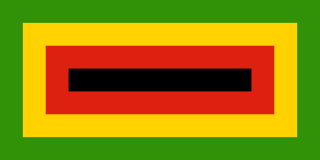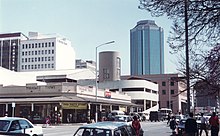
Harare, formerly Salisbury, is the capital and largest city of Zimbabwe. The city proper has an area of 982.3 km2 (379.3 sq mi), a population of 1,849,600 as of the 2022 census and an estimated 2,487,209 people in its metropolitan province. The city is situated in north-eastern Zimbabwe in the country's Mashonaland region. Harare is a metropolitan province which also incorporates the municipalities of Chitungwiza and Epworth. The city sits on a plateau at an elevation of 1,483 metres above sea level, and its climate falls into the subtropical highland category.

The Zimbabwe African National Union – Patriotic Front (ZANU–PF) is a political organisation which has been the ruling party of Zimbabwe since independence in 1980. The party was led for many years by Robert Mugabe, first as prime minister with the Zimbabwe African National Union (ZANU) and then as president from 1987 after the merger with the Zimbabwe African People's Union (ZAPU) and retaining the name ZANU–PF, until 2017, when he was removed as leader.
Racism in Zimbabwe was introduced during the colonial era in the 19th century, when emigrating white settlers began racially discriminating against the indigenous Africans living in the region. The colony of Southern Rhodesia and state of Rhodesia were both dominated by a white minority, which imposed racist policies in all spheres of public life. In the 1960s–70s, African national liberation groups waged an armed struggle against the white Rhodesian government, culminating in a peace accord that brought the ZANU–PF to power but which left much of the white settler population's economic authority intact.
The following is a timeline of the history of the city of Nairobi, Kenya.
The following is a timeline of the history of the city of Lusaka, Zambia.
The following is a timeline of the history of the city of Freetown, Sierra Leone.
The following is a timeline of the history of the city of Lomé, Togo.
The following is a timeline of the history of the city of Gaborone, Botswana.
Charles Mzingeli (1905–1980) grew up on a Catholic mission station near Plumtree in Southern Rhodesia, now Zimbabwe. At the age of 14 he ran away to work on the railways, before moving to Bulawayo, where he became involved in the Industrial and Commercial Workers' Union (ICU), and worked with figures like 'Sergeant' Masotsha Ndlovu. The ICU, a radical trade union, started in South Africa in 1919, but spread into neighboring colonies in the 1920s and 1930s. In 1929 Mzingeli was sent to Harare Township at Salisbury as the ICU's organizing secretary. The ICU disintegrated in South Africa as well as in Southern Rhodesia in the 1930s, but it had pioneered black trade unionism in the latter, where it had played a major role in both urban and rural protests.
Victoria Fikile Chitepo was a South African - Zimbabwean politician, activist and educator. She was the wife of Herbert Chitepo, a leading figure in the Zimbabwe African National Union (ZANU), but was a major political figure in her own right and served as a minister in the government of independent Zimbabwe between 1980–1992.
The following is a timeline of the history of the city of Niamey, Niger.
The following is a timeline of the history of the city of Lilongwe, Malawi.
The following is a timeline of the history of the city of Windhoek, Namibia.
The following is a timeline of the history of the city of Yaoundé, Cameroon.
The following is a timeline of the history of the city of Bulawayo, Zimbabwe.
Bissau is a city in Guinea-Bissau, a country in West Africa, formerly part of the kingdom of Kaabu and part of the Mali Empire.
The following is a timeline of the history of the city of Kigali, Rwanda.

Oriah Anthony Gara was a Zimbabwean businessman and politician. He was a member of the House of Assembly of Zimbabwe for Mbare East from 1990 to 2000 and served as deputy minister of local government, rural and urban development from 1995 until 2000. Before entering Parliament, he was a member of the Harare City Council and served as mayor of Harare from 1985 to 1986.
Italian Zimbabweans are citizens or residents of Zimbabwe of Italian heritage. The phrase may refer to someone born in the Zimbabwe of Italian descent, someone who has emigrated from Italy to Zimbabwe, a person with Italo-Zimbabwean heritage or someone born elsewhere, who is of Italian descent and has migrated to Zimbabwe. Italian Zimbabweans form one of the younger communities of the Italian diaspora, largely a product of wartime and post-war immigration.








